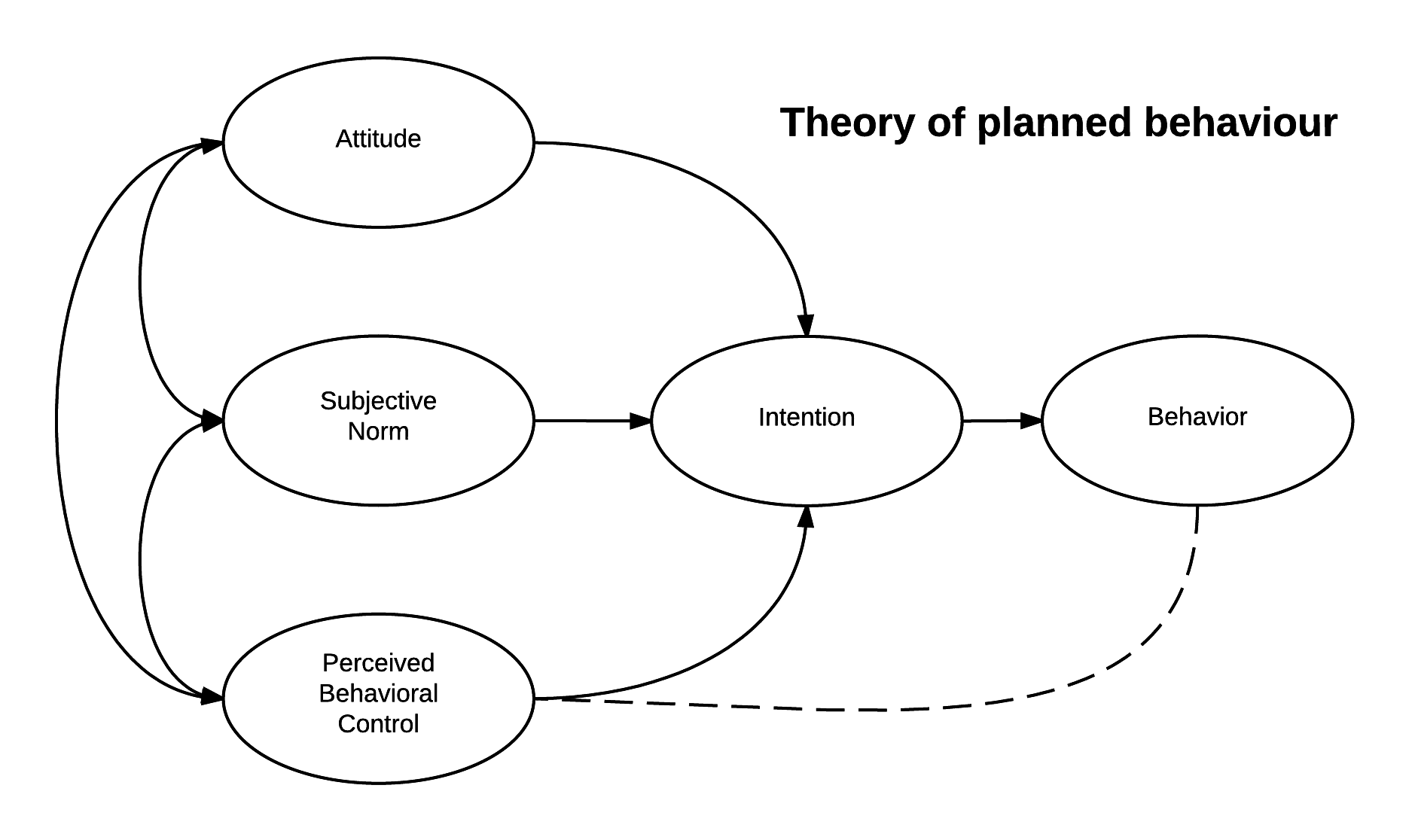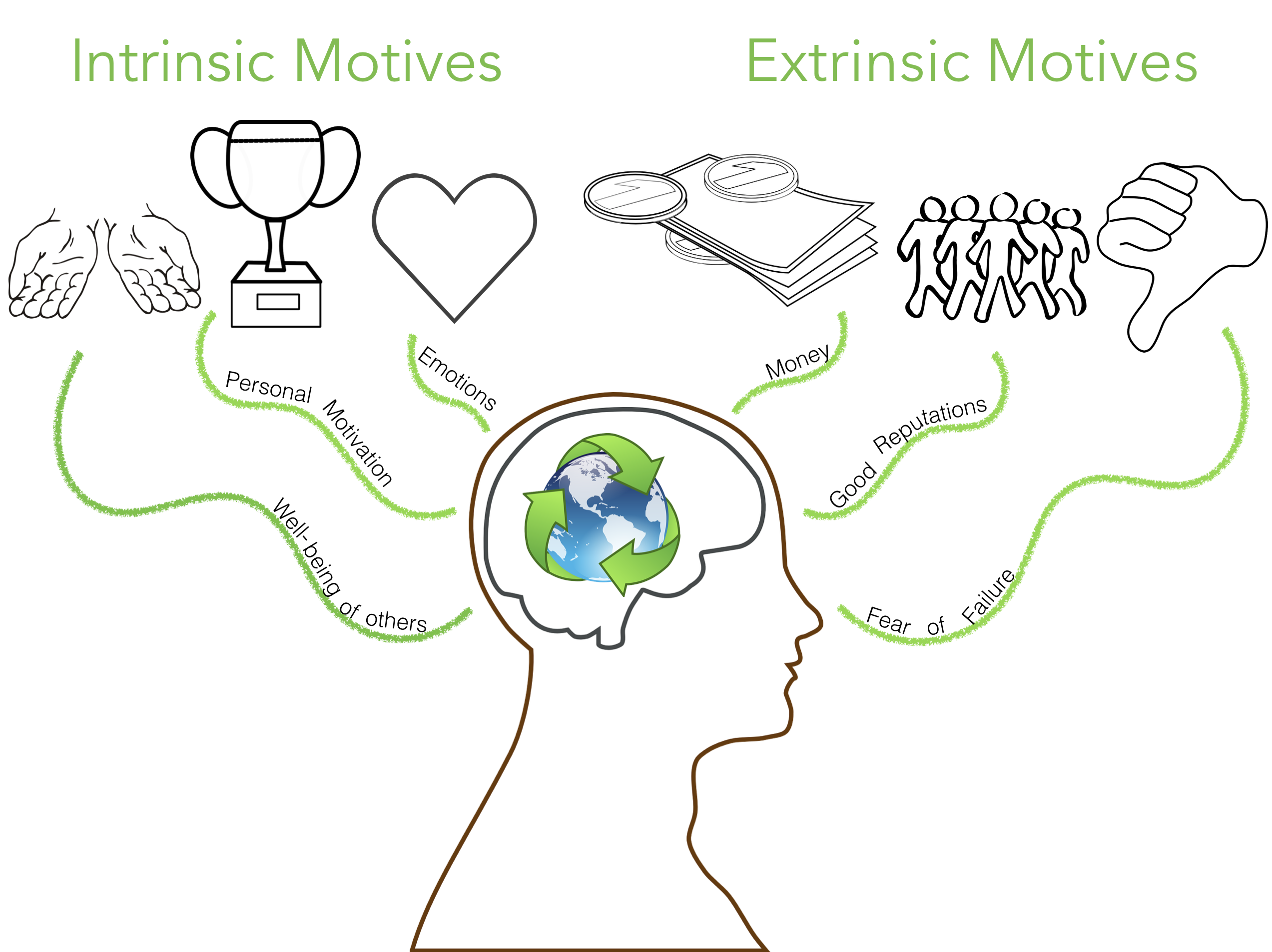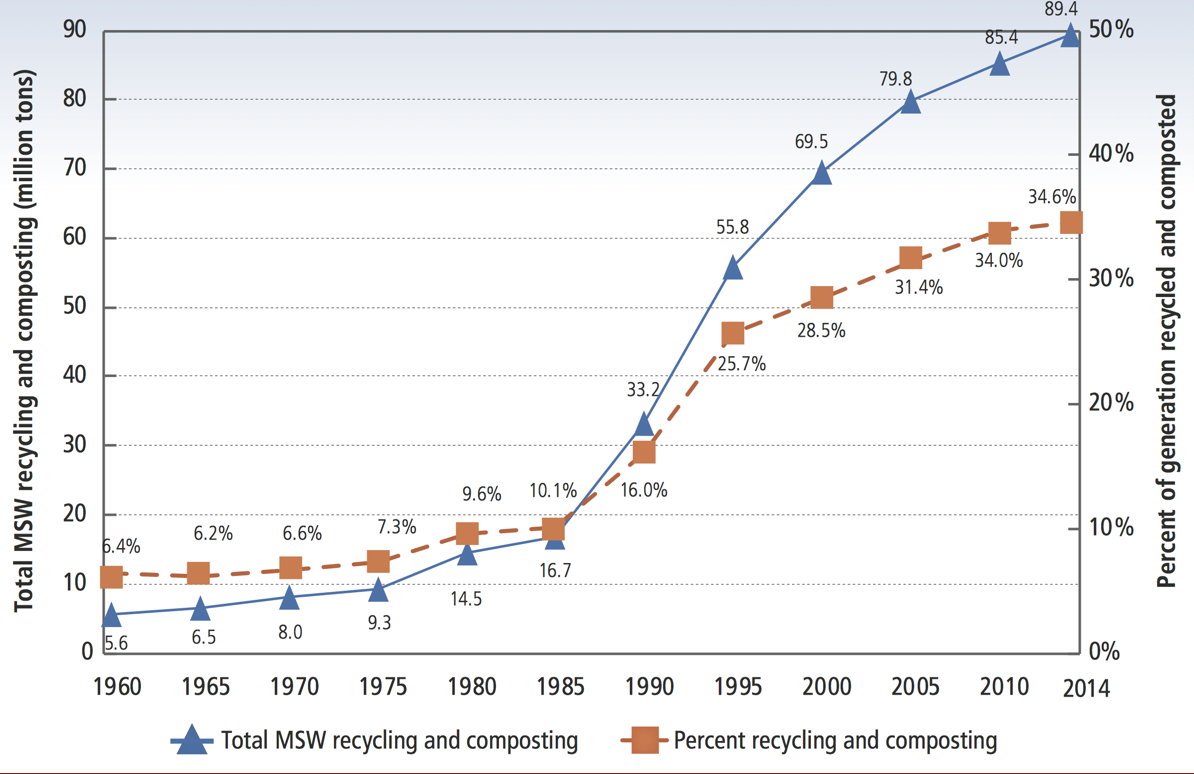Sustainability
5.6 Deciding to Recycle: A Psychological Perspective
Rebecca L. Sallade
What encourages individuals to recycle? Are their actions influenced by their beliefs or other actions? Intrinsic and extrinsic motivators work together to lead to pro-environmental behavior in the United States.

In recent years, the global community has attempted to boost the motivation to recycle in various ways. The United States has tried to encourage pro-environmental behavior, but the results have not been radically significant. However, it is important to understand what influences pro-environmental behavior so that more communities can utilize these tactics to achieve better results. Both intrinsic and extrinsic factors need to be considered, and various theories are available to promote environmental health (Figure 3).
In the Theory of Planned Behavior, values, beliefs, and other intrinsic values all contribute to whether or not an individual decides to participate in pro-environmental behavior.4,5 Deep beliefs and values often result in behavior, and studying what individuals value can give an insight about their environmental mindset.6 The Theory of Planned Behavior helps predict what intentions will turn into actions, and the degree of control a person has over what intentions turn into actions.4,5 This theory is more effective when an individual’s environment and emotions are taken into account.2 Decision making stems from the ability to understand one’s beliefs; the greater the clarity, the more likely an individual is to carry out the action.2 Understanding emotional intelligence can help determine how an individual adapts to their environment, and this can lead to the identification of what emotions were triggered by intrinsic motives.2 According to the theory, different interpretations can arise from the same situation, thus, researching the context can help clarify the cognitive process.6

In comparison, the self-determination theory can also be utilized to help predict the likelihood of pro-environmental actions.6 This theory describes motivated behavior as part of a continuum that ranges from autonomous to controlled actions.6 This continuum consists of intrinsic, integrated, identified, introjected, and extrinsic constructs.6 Another intrinsic motivator is the warm-glow effect, which consists of personal satisfaction and altruistic motives that benefit the well-being of others.1 Individuals “feel good” for partaking in pro-environmental behaviors and continue to repeat the activities regardless of extrinsic rewards.1
However, extrinsic motivators are just as important to the decision making process.3 Common extrinsic motives include monetary and social rewards, such as tax breaks and a good reputation.1,3 On many occasions, individuals are not likely to recycle because of the time cost, the lack of monetary reward, and possible charges associated with recycling.1 It is understandable that less people are likely to recycle when given this situation.1,4 Individuals are more likely to recycle in the workplace rather than their households due to the direct “visible” cost from home bills.5 Consumerism causes excess waste while nothing is being done to reduce the disposables.4 Social norms may also play a large part in this process, as individuals attempt to conform to ideal perceptions and thus their behaviors are altered.1 Conformity is a very relevant extrinsic motivator, and different organizations in the United States are attempting to spread pro-environmental behavior throughout the culture.1 In many communities, the majority of the population has adapted an anthropogenic, or human-based perspective, and have little to no concern about the wellbeing of their environment.2 Social norms contribute to the percentage of the United States population that chooses to engage in pro-environmental behavior.4 Norms can predict actions and are also said to be the antecedents of certain attitudes.1,4 Attitudes, subjective norms, moral norms, and perceived behavioral controls generate environmental intentions, which in turn can result in actions, such as recycling.4 Other factors that contribute to the process include an environmental worldview and surrounding social influence.6 An individual’s worldview contributes to behavioral demonstration while social norms influence behavioral intention.1,6 Both factors are necessary for optimal pro-environmental behaviors.1,6 In most cases, the peer effect seems to be the most effective factor.1 The effect contributes to the kerbside scheme, which solidifies norms, provides the means for a behavior, and can sometimes give a warm-glow effect.1 The scheme provides norm awareness, and most of the people in a society will try to conform.1 Displaying pro-social behavior is important to “fit in”, and recycling (or the lack of recycling) can be a result of this phenomenon.3

Over the years, the United States has implemented various programs and awareness campaigns to try to make recycling a pro-social behavior, but the results have not been as significant as the country originally hoped. The average American still produces 1,600 pounds of trash annually, and although environmentally-friendly programs have attempted to encourage recycling to control this, the amount of trash produced is still an issue.7 Various programs have made it their mission to encourage recycling, however not enough campaigns have made an effort to reduce the initial amount of waste.3 Consumers are more likely to buy what is convenient, so education about what to buy and how to dispose of it is crucial.8 Changing human behavior is the first step; educating people could help them reconsider their actions, and pro-environmental efforts may become more common.5 Morris (2011) emphasizes how recycling can be made worthwhile through monetary reward programs, family-oriented goals, and conveniences like homemade fertilizer.7 Morris (2011) also provides solutions for recycling electronic waste, which utilize monetary rewards and are crucial because the buildup of electronic waste is potentially the most harmful.7 Electronic waste makes up 70% of the toxic material in landfills.7
Through the promotion and adoption of pro-environmental behaviors such as recycling, individuals can reduce the consumption and waste of natural resources and energy.4,7 However, a great percentage of the United States population does not view environmental problems as moral concerns, and because of this fewer actions are taken to promote environmental health. To improve this, morals, norms, and intrinsic motivators must be utilized to make social changes. Abbott (2013) also argues that the focus of awareness should be on the voluntary nature of pro-environmental behaviors instead of mandatory aspects.1 However, the different control levels of motivation are likely to yield only temporary results.6,8 The temporal construal theory articulates how competing motivations can change over time, thus short-term goals are likely to interfere with long-term plans.8 Because of this, acting on “here and now” goals are said to be more effective.8 Understanding the relationship between short and long-term goals is a paramount to developing effective policies. It is important to realize that automatic evaluations, or impulses, can drive actions of individuals.8 This can be depicted through recycling campaigns, Earth Day, and other pro-environmental movements. The effects are likely to last for a short amount of time, yet society will get a warm-glow effect from the behaviors that they undertake.1,3 Goal priming is also a motivator, and Tate’s (2014) study emphasizes that using goal priming led to more environmentally-friendly goals.8 Examples such as available recycling bins, green packaging, posters, and other subliminal priming paradigms have been successful in many studies.8 An increased cognitive accessibility of pro-environmental behavior has led to more effective behaviors.8

Deciding whether or not to recycle is a psychological, sociological, and environmental decision. Both intrinsic and extrinsic factors play a role in the cognitive process, and understanding how solutions influence an individual’s behavior can improve their success rates for the future. Policymakers at all levels of government in the United States should consider these factors when implementing pro-environmental policies.
References:
- Abbott, A., et al. (2013). Recycling: Social norms and warm-glow revisited. Ecological Economics. 90:10-18.
- Aguilar-Luzón, M.C., et al. (2014). Beliefs and environmental behavior: The moderating effect of emotional intelligence. Scandinavian Journal of Psychology. 55(6):619-629.
- Cecere, G., et al. (2014). Waste prevention and social preferences: the role of intrinsic and extrinsic motivations. Ecological Economics. 107:163-176.
- Chan, L. & Bishop, B. (2013). A moral basis for recycling: Extending the theory of planned behavior. Journal of Environmental Psychology. 36:96-102.
- Greaves, M., et al. (2013). Using the theory of planned behavior to explore environmental behavioral intentions in the workplace. Journal of Environmental Psychology. 34: 109-120.
- Huffman, Ann H., et al. (2014). When do recycling attitudes predict recycling? An investigation of self-reported versus observed behavior. Journal of Environmental Psychology. 38:262-270..
Morris, Jason (2011, November 15). 5 Ways to Make Recycling Pay. National Geographic. Retrieved from: - http://energyblog.nationalgeographic.com/2011/11/15/five-ways-to-make-recycling-pay/.
- Tate, Kelly, et al. (2014). Influencing green behavior through environmental goal priming: The mediating role of automatic evaluation. Journal of Environmental Psychology. 38:225-232.
- Woolfolk, Anita (2013). Educational Psychology. Columbus, OH: Pearson.
Figures:
- Clker-Free-Vector-Images. (2014). [Brain: motives graphic]. Retrieved from Pixabay. Public Domain.
- Clker-Free-Vector-Images. (2012). [Earth: motives graphic]. Retrieved from Pixabay. Public Domain.
- Clker-Free-Vector-Images. (2012). [People: motives graphic. Retrieved from Pixabay.
- Clker-Free-Vector-Images. (2014). [Trophy: motives graphic]. Retrieved from Pixabay. Public Domain.
- Orzanna, Robert. (2015). [Diagram of theory of planned behavior]. Retrieved from Wikimedia Commons. CC BY-SA 4.0.
- petrap555. (2015). [Hands: motives graphic]. Retrieved from Pixabay. Public Domain.
- Skitterphoto. (2015). [Photograph of soda can on wood dock]. Retrieved from Pixabay. Public Domain.
- United States Environmental Protection Agency, Office of Land and Emergency Management. (2016). Advancing Sustainable Materials Management 2014 Fact Sheet. [Graph of recycling rates]. Retrieved from https://www.epa.gov/sites/production/files/2016-11/documents/2014_smmfactsheet_508.pdf.
